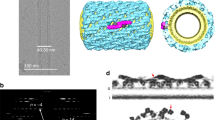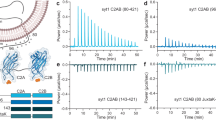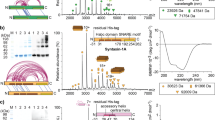Abstract
In neurons, SNAREs, synaptotagmin and other factors catalyze Ca2+-triggered fusion of vesicles with the plasma membrane. The molecular mechanism of this process, especially the interaction between synaptotagmin and SNAREs, remains an enigma. Here we characterized this interaction by single-molecule fluorescence microscopy and crystallography. The two rigid Ca2+-binding domains of synaptotagmin 3 (Syt3) undergo large relative motions in solution. Interaction with SNARE complex amplifies a particular state of the two domains that is further enhanced by Ca2+. This state is represented by the first SNARE-induced Ca2+-bound crystal structure of a synaptotagmin fragment containing both domains. The arrangement of the Ca2+-binding loops of this structure of Syt3 matches that of SNARE-bound Syt1, suggesting a conserved feature of synaptotagmins. The loops resemble the membrane-interacting loops of certain viral fusion proteins in the postfusion state, suggesting unexpected similarities between both fusion systems.
This is a preview of subscription content, access via your institution
Access options
Subscribe to this journal
Receive 12 print issues and online access
$189.00 per year
only $15.75 per issue
Buy this article
- Purchase on Springer Link
- Instant access to full article PDF
Prices may be subject to local taxes which are calculated during checkout






Similar content being viewed by others
References
Jahn, R. & Scheller, R.H. SNAREs–engines for membrane fusion. Nat. Rev. Mol. Cell Biol. 7, 631–643 (2006).
Harrison, S.C. Viral membrane fusion. Nat. Struct. Mol. Biol. 15, 690–698 (2008).
Sudhof, T.C. The synaptic vesicle cycle. Annu. Rev. Neurosci. 27, 509–547 (2004).
Fernandez-Chacon, R. et al. Synaptotagmin I functions as a calcium regulator of release probability. Nature 410, 41–49 (2001).
Pang, Z.P., Shin, O.H., Meyer, A.C., Rosenmund, C. & Sudhof, T.C. A gain-of-function mutation in synaptotagmin-1 reveals a critical role of Ca2+-dependent soluble N-ethylmaleimide–sensitive factor attachment protein receptor complex binding in synaptic exocytosis. J. Neurosci. 26, 12556–12565 (2006).
Weber, T. et al. SNAREpins: minimal machinery for membrane fusion. Cell 92, 759–772 (1998).
Sugita, S., Shin, O.H., Han, W., Lao, Y. & Sudhof, T.C. Synaptotagmins form a hierarchy of exocytotic Ca2+ sensors with distinct Ca2+ affinities. EMBO J. 21, 270–280 (2002).
Herrick, D.Z., Sterbling, S., Rasch, K.A., Hinderliter, A. & Cafiso, D.S. Position of synaptotagmin I at the membrane interface: cooperative interactions of tandem C2 domains. Biochemistry 45, 9668–9674 (2006).
Hui, E., Bai, J. & Chapman, E.R. Ca2+-triggered simultaneous membrane penetration of the tandem C2-domains of synaptotagmin I. Biophys. J. 91, 1767–1777 (2006).
Martens, S., Kozlov, M.M. & McMahon, H.T. How synaptotagmin promotes membrane fusion. Science 316, 1205–1208 (2007).
Arac, D. et al. Close membrane-membrane proximity induced by Ca2+-dependent multivalent binding of synaptotagmin-1 to phospholipids. Nat. Struct. Mol. Biol. 13, 209–217 (2006).
Stein, A., Radhakrishnan, A., Riedel, D., Fasshauer, D. & Jahn, R. Synaptotagmin activates membrane fusion through a Ca2+-dependent trans interaction with phospholipids. Nat. Struct. Mol. Biol. 14, 904–911 (2007).
Bhalla, A., Chicka, M.C. & Chapman, E.R. Analysis of the synaptotagmin family during reconstituted membrane fusion. Uncovering a class of inhibitory isoforms. J. Biol. Chem. 283, 21799–21807 (2008).
Mittelsteadt, T. et al. Differential mRNA expression patterns of the synaptotagmin gene family in the rodent brain. J. Comp. Neurol. 512, 514–528 (2009).
Li, C. et al. Ca2+-dependent and -independent activities of neural and non-neural synaptotagmins. Nature 375, 594–599 (1995).
Xu, J., Mashimo, T. & Sudhof, T.C. Synaptotagmin-1, -2, and -9: Ca2+ sensors for fast release that specify distinct presynaptic properties in subsets of neurons. Neuron 54, 567–581 (2007).
Tang, J. et al. A complexin/synaptotagmin 1 switch controls fast synaptic vesicle exocytosis. Cell 126, 1175–1187 (2006).
Choi, U. et al. Single molecule FRET derived model of the synaptotagmin 1–SNARE fusion complex. Nat. Struct. Mol. Biol. advance online publication, doi:10.1038/nsmb.1763 (21 February 2010).
Fuson, K.L., Montes, M., Robert, J.J. & Sutton, R.B. Structure of human synaptotagmin 1 C2AB in the absence of Ca2+ reveals a novel domain association. Biochemistry 46, 13041–13048 (2007).
Sutton, R.B., Ernst, J.A. & Brunger, A.T. Crystal structure of the cytosolic C2A–C2B domains of synaptotagmin III. Implications for Ca+2-independent snare complex interaction. J. Cell Biol. 147, 589–598 (1999).
Gibbons, D.L. et al. Conformational change and protein-protein interactions of the fusion protein of Semliki Forest virus. Nature 427, 320–325 (2004).
Dormitzer, P.R., Nason, E.B., Prasad, B.V. & Harrison, S.C. Structural rearrangements in the membrane penetration protein of a non-enveloped virus. Nature 430, 1053–1058 (2004).
Jarousse, N., Wilson, J.D., Arac, D., Rizo, J. & Kelly, R.B. Endocytosis of synaptotagmin 1 is mediated by a novel, tryptophan-containing motif. Traffic 4, 468–478 (2003).
Kielian, M., Klimjack, M.R., Ghosh, S. & Duffus, W.A. Mechanisms of mutations inhibiting fusion and infection by Semliki Forest virus. J. Cell Biol. 134, 863–872 (1996).
Dowling, W., Denisova, E., LaMonica, R. & Mackow, E.R. Selective membrane permeabilization by the rotavirus VP5* protein is abrogated by mutations in an internal hydrophobic domain. J. Virol. 74, 6368–6376 (2000).
Joo, C., Balci, H., Ishitsuka, Y., Buranachai, C. & Ha, T. Advances in single-molecule fluorescence methods for molecular biology. Annu. Rev. Biochem. 77, 51–76 (2008).
Huang, H. & Cafiso, D.S. Conformation and membrane position of the region linking the two C2 domains in synaptotagmin 1 by site-directed spin labeling. Biochemistry 47, 12380–12388 (2008).
Weninger, K., Bowen, M.E., Choi, U.B., Chu, S. & Brunger, A.T. Accessory proteins stabilize the acceptor complex for synaptobrevin, the 1:1 syntaxin/SNAP-25 complex. Structure 16, 308–320 (2008).
Giraudo, C.G. et al. Alternative zippering as an on-off switch for SNARE-mediated fusion. Science 323, 512–516 (2009).
Maximov, A., Tang, J., Yang, X., Pang, Z.P. & Sudhof, T.C. Complexin controls the force transfer from SNARE complexes to membranes in fusion. Science 323, 516–521 (2009).
Sorensen, J.B. et al. Sequential N- to C-terminal SNARE complex assembly drives priming and fusion of secretory vesicles. EMBO J. 25, 955–966 (2006).
Chan, Y.H., van Lengerich, B. & Boxer, S.G. Effects of linker sequences on vesicle fusion mediated by lipid-anchored DNA oligonucleotides. Proc. Natl. Acad. Sci. USA 106, 979–984 (2009).
Jun, Y. & Wickner, W. Assays of vacuole fusion resolve the stages of docking, lipid mixing, and content mixing. Proc. Natl. Acad. Sci. USA 104, 13010–13015 (2007).
Floyd, D.L., Ragains, J.R., Skehel, J.J., Harrison, S.C. & van Oijen, A.M. Single-particle kinetics of influenza virus membrane fusion. Proc. Natl. Acad. Sci. USA 105, 15382–15387 (2008).
Katsov, K., Muller, M. & Schick, M. Field theoretic study of bilayer membrane fusion: II. Mechanism of a stalk-hole complex. Biophys. J. 90, 915–926 (2006).
Zimmerberg, J. & Gawrisch, K. The physical chemistry of biological membranes. Nat. Chem. Biol. 2, 564–567 (2006).
Giraudo, C.G. et al. SNAREs can promote complete fusion and hemifusion as alternative outcomes. J. Cell Biol. 170, 249–260 (2005).
Kasson, P.M. et al. Ensemble molecular dynamics yields submillisecond kinetics and intermediates of membrane fusion. Proc. Natl. Acad. Sci. USA 103, 11916–11921 (2006).
Katsov, K., Muller, M. & Schick, M. Field theoretic study of bilayer membrane fusion. I. Hemifusion mechanism. Biophys. J. 87, 3277–3290 (2004).
Muller, M., Katsov, K. & Schick, M. A new mechanism of model membrane fusion determined from Monte Carlo simulation. Biophys. J. 85, 1611–1623 (2003).
Chernomordik, L.V., Leikina, E., Frolov, V., Bronk, P. & Zimmerberg, J. An early stage of membrane fusion mediated by the low pH conformation of influenza hemagglutinin depends upon membrane lipids. J. Cell Biol. 136, 81–93 (1997).
Melia, T.J., You, D., Tareste, D.C. & Rothman, J.E. Lipidic antagonists to SNARE-mediated fusion. J. Biol. Chem. 281, 29597–29605 (2006).
Cooke, I.R. & Deserno, M. Coupling between lipid shape and membrane curvature. Biophys. J. 91, 487–495 (2006).
Tian, A. & Baumgart, T. Sorting of lipids and proteins in membrane curvature gradients. Biophys. J. 96, 2676–2688 (2009).
Wang, H. et al. Bilayer edge and curvature effects on partitioning of lipids by tail length: atomistic simulations. Biophys. J. 95, 2647–2657 (2008).
Kemble, G.W., Danieli, T. & White, J.M. Lipid-anchored influenza hemagglutinin promotes hemifusion, not complete fusion. Cell 76, 383–391 (1994).
Gilbert, J.M. & Greenberg, H.B. Virus-like particle-induced fusion from without in tissue culture cells: role of outer-layer proteins VP4 and VP7. J. Virol. 71, 4555–4563 (1997).
Ernst, J.A. & Brunger, A.T. High resolution structure, stability, and synaptotagmin binding of a truncated neuronal SNARE complex. J. Biol. Chem. 278, 8630–8636 (2003).
Otwinowski, Z.M.W. Processing of X-ray diffraction data collected in oscillation mode. Methods Enzymol. 276, 307–326 (1997).
Emsley, P. & Cowtan, K. Coot: model-building tools for molecular graphics. Acta Crystallogr. D Biol. Crystallogr. 60, 2126–2132 (2004).
Brunger, A.T. et al. Crystallography & NMR system: A new software suite for macromolecular structure determination. Acta Crystallogr. D Biol. Crystallogr. 54, 905–921 (1998).
Adams, P.D. et al. PHENIX: building new software for automated crystallographic structure determination. Acta Crystallogr. D Biol. Crystallogr. 58, 1948–1954 (2002).
Wozniak, A.K., Schroder, G.F., Grubmuller, H., Seidel, C.A. & Oesterhelt, F. Single-molecule FRET measures bends and kinks in DNA. Proc. Natl. Acad. Sci. USA 105, 18337–18342 (2008).
Engh, R. & Huber, R. Accurate bond and ange parameters for X-ray protein structure refinement. Acta Crystallogr. A 47, 392–400 (1991).
Brunger, A.T. X-PLOR, Version 3.1. A System for X-ray Crystallography and NMR. (Yale Unversity Press, New Haven, Connecticut, USA, 1992).
Acknowledgements
We thank T. Südhof and J. Rizo for discussions, Y. Zhang, B. Cui, S. Solomatin, T.H. Lee and A. Persitidinis for discussions of single-molecule experimental setup and data analysis, Y. Abdiche and K. Lindquist for technical assistance and discussions of biosensor experiments, and the US National Institutes of Health for support to A.T.B (RO1-MH63105). A.T.B. presented this work at the first Paul B. Sigler lecture at Yale University on 23 March 2009.
Author information
Authors and Affiliations
Contributions
J.A.E. and R.B.S. purified, crystallized and collected diffraction data; P.S. processed, solved and refined the Syt3 structure; M.V. collected and analyzed single-molecule data; M.V. and P.S. designed and purified proteins used in single-molecule studies and prepared the manuscript; A.T.B., M.V., P.S. and S.C. performed experimental design, data analysis and manuscript preparation.
Corresponding author
Ethics declarations
Competing interests
The authors declare no competing financial interests.
Supplementary information
Supplementary Text and Figures
Supplementary Figures 1–11, Supplementary Table 1 and Supplementary Methods (PDF 9640 kb)
Rights and permissions
About this article
Cite this article
Vrljic, M., Strop, P., Ernst, J. et al. Molecular mechanism of the synaptotagmin–SNARE interaction in Ca2+-triggered vesicle fusion. Nat Struct Mol Biol 17, 325–331 (2010). https://doi.org/10.1038/nsmb.1764
Received:
Accepted:
Published:
Issue Date:
DOI: https://doi.org/10.1038/nsmb.1764
This article is cited by
-
D6 protein kinase in root xylem benefiting resistance to Fusarium reveals infection and defense mechanisms in tung trees
Horticulture Research (2021)
-
Function of Drosophila Synaptotagmins in membrane trafficking at synapses
Cellular and Molecular Life Sciences (2021)
-
Proteome Analysis of Potential Synaptic Vesicle Cycle Biomarkers in the Cerebrospinal Fluid of Patients with Sporadic Creutzfeldt–Jakob Disease
Molecular Neurobiology (2017)
-
cBid, Bax and Bcl-xL exhibit opposite membrane remodeling activities
Cell Death & Disease (2016)
-
Molecular origins of synaptotagmin 1 activities on vesicle docking and fusion pore opening
Scientific Reports (2015)



